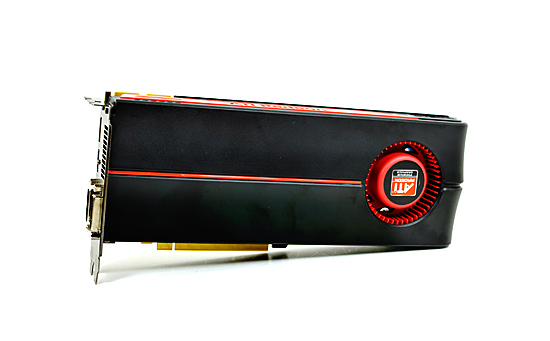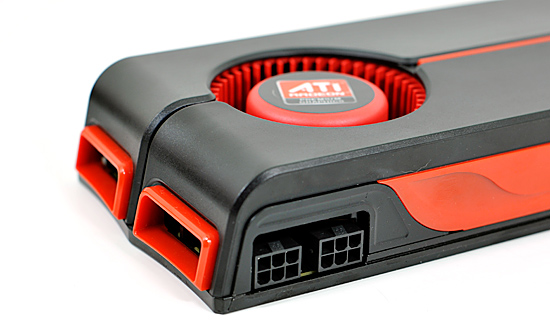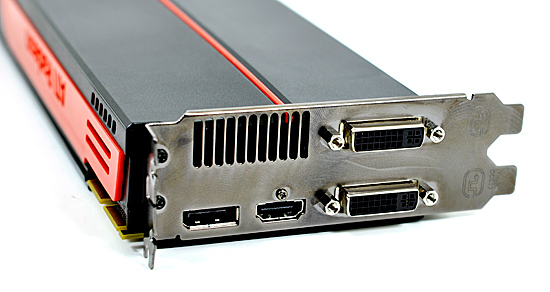AMD's Radeon HD 5870: Bringing About the Next Generation Of GPUs
by Ryan Smith on September 23, 2009 9:00 AM EST- Posted in
- GPUs
Meet the 5870
The card we’re looking at today is the Radeon HD 5870, based on the Cypress core.

Compared to the Radeon HD 4870, the 5870 has seen some changes to the board design. AMD has now moved to using a full sheath on their cards (including a backplate), very much like the ones that NVIDIA has been using since the 9800GTX. The card measures 10.5” long, an inch longer than the 4890 or the same as the 4870x2 and the NVIDIA GTX lineup.
The change in length means that AMD has moved the PCIe power connectors to the top of the card facing upwards, as there’s no longer enough room in the rear. Facing upwards is also a change from the 4870x2, which had them facing the front of the card. This, in our opinion, makes it easier to plug and unplug the PCIe power connectors, since it’s now possible to see what you’re doing.
Since the card has a TDP of 188W, AMD can still get away with using two 6-pin connectors. This is going to be good news for those of you with older power supplies that don’t feature 8-pin connectors, as previously the fastest cards without 8-pin connectors were the 4890 and GTX 285.

Briefly, the 5850 that we are not testing today will be slightly smaller than the 5870, coming in at 9.5”. It keeps the same cooler design, however the PCIe power connectors are back on the rear of the card.
With the 5800 series, DisplayPort is getting a much-needed kick in the pants. DisplayPort (full size) is standard on all 5800 series cards – prior to this it has been rather absent on reference cards. Along with a DisplayPort, the 5870 reference card contains a dedicated HDMI port, and a pair of DVI ports.
Making 4 ports fit on a card isn’t a trivial task, and AMD has taken an interesting direction in making it happen. Rather than putting every port on the same slot of the bracket as the card itself, one of the DVI ports is raised on to the other bracket. ATI could have just as easily only equipped these cards with 1 DVI port, and used an HDMI-to-DVI adapter for the second port. The advantage of going this direction is that the 5800 series can still drive two VGA monitors when using DVI-to-VGA adapters, and at the same time having an HDMI port built in means that no special adapters are necessary to get an HDMI port with audio capabilities. The only catch to this specific port layout is that the card still only has enough TMDS transmitters for two ports. So you can use 2x DVI or 1x DVI + HDMI, but not 2x DVI + HDMI. For 3 DVI-derived ports, you will need an active DisplayPort-to-DVI adapter.
With the configuration AMD is using, fitting that second DVI port also means that the exhaust vent of the 5800 series cards is not the full length of the card as is usually common, rather it’s a hair over half the length. The smaller size had us concerned about the 5870’s cooling capabilities, but as you’ll see with our temperature data, even with the smaller exhaust vent the load temperatures are no different than the 4870 or 4850, at 89C. And this is in spite of the fact that the 5870 is rated 28W more than the 4870.

With all of these changes also comes some changes to the loudness of the 5870 as compared to the 4870. The 27W idle power load means that AMD can reduce the speed of the fan some, and they say that the fan they’re using now is less noticeable (but not necessarily quieter) than what was on the 4870. In our objective testing the 5870 was no quieter than any of the 4800 series cards when it comes to idling at 46.6dB, and indeed it’s louder than any of those cards at 64dB at load. But in our subjective testing it has less of a whine. If you go by the objective data, this is a push at idle and louder at load.
Speaking of whining, we’re glad to report that the samples we received do not have the characteristic VRM whine/singing that has plagued many last-generation video cards. Most of our GTX cards and roughly half of our 4800 series cards generated this noise under certain circumstances, but the 5870 does not.
Finally, let’s talk about memory. Despite of doubling just about everything compared to RV770, Cypress and the 5800 series cards did not double their memory bandwidth. Moving from the 4870 and it’s 900MHz base memory clock, the 5870 only jumps up by 33% to 1.2Ghz, in effect increasing the ratio of GPU compute elements to memory bandwidth.
When looking back at the RV770, AMD believes that they were not bandwidth starved on the cards that used GDDR5. And since they had more bandwidth than they needed, it was not necessary to go for significantly more bandwidth for Cypress. This isn’t something we can easily test, but in our benchmarks the 5870 never doubles the performance of the 4870, in spite of being nearly twice the card. Graphics processing is embarrassingly parallel, but that doesn’t mean it perfectly scales. The different may be a product of that or a product of the lack of scaling in memory bandwidth, we can’t tell. What’s for certain however is that we don’t have any hard-capped memory bandwidth limited situations, the 5870 always outscores the 4870 by a great deal more than 33%.










327 Comments
View All Comments
SiliconDoc - Wednesday, September 30, 2009 - link
No, it's the fact you tell LIES, and always in ati's favor, and you got caught, over and over again.That is WHAT HAS HAPPENED.
Now you catch hold of your senses for a moment, and supposedly all the crap you spewed is "ok".
SiliconDoc - Friday, September 25, 2009 - link
Once again, all that matters to YOU, is YOUR games for PC, and ONLY top sellers, and only YOUR OPINION on PhysX.However, after you claimed only 2 games, you went on to bloviate about Havok.
Now you've avoided entirely that issue. Am I to assume, as you have apparently WISHED and thrown about, that HAVOK does not function on NVidia cards? NO QUITE THE CONTRARY !
--
What is REAL, is that NVidia runs Havok AND PhysX just fine, and not only that but ATI DOES NOT.
Now, instead of supporting BOTH, you have singled out your object of HATRED, and spewed your infantile rants, your put downs, your empty comparisons (mere statements), then DEMAND that I show PhysX is worthwhile, with "golden sellers". LOL
It has been 1.5 years or so since Aegia acquisition, and of course, game developers turning anything out in just 6 short months are considered miracle workers.
The real problem oif course for you is ATI does not support PhysX, and when a rouge coder made it happen, NVidia supported him, while ATI came in and crushed the poor fella.
So much for "competition", once again.
Now, I'd demand you show where HAVOK is worthwhile, EXCEPT I'm not the type of person that slams and reams and screams against " a percieved enemy company" just because "my favorite" isn't capable, and in that sense, my favorite IS CAPABLE.
Now, PhysX is awesome, it's great, it's the best there is, and that may or may not change, but as for now, NO OTHER demonstrations (you tube and otherwise) can match it.
That's just a sad fact for you, and with so many maintaining your biased and arrogant demand for anything else, we may have another case of VHS instead of BETA, which of course, you would heartily celebrate, no matter how long it takes to get there.
LOL
Yes, it is funny. It's just hilarious. A few months ago before Mirror's Edge and Anand falling in love with PhysX in it, admittedly, in the article he posted, we had the big screamers whining ZERO.
Well, now a few months later you are whining TWO.
Get ready to whine higher. Yes, you have read about the uptick in support ? LOL
You people are really something.
Oh, I know, CUDA is a big fat zero according to you, too.
(please pass along your thoughts to higher education universities here in the USA, and the federal government national lab research facilites. Thanks)
SiliconDoc - Thursday, September 24, 2009 - link
Yes, another excuse monger. So you basically admit the text is biased, and claim all readers should see the charts and go by those. LOLSo when the text is biased, as you admit, how is it that the rest, the very core of the review is not ? You won't explain that either.
Furthermore, the assumption that competition leads to something better in technology for videocards quicker, fails the basic test that in terms of technology, there is a limit to how fast it proceeds forward, since scientific breakthroughs must come, and often don't come, for instance, new energy technologies, still struggling after decades to make a breakthrough, with endless billions spent, and not much to show for it.
Same here with videocards, there is a LIMIT to the advancement speed, and competition won't be able to exceed that limit.
Furthermore, I NEVER said prices won't be driven down by competition, and you falsely asserted that notion to me.
I DID however say, ATI ALSO IS KNOWN FOR OVERPRICING. (or rather unknown by the red fans, huh, even said by omission to have NOT COMMITTED that "huge sin", that you all blame only Nvidia for doing.)
So you're just WRONG once again.
Begging the other guy to "not argue" then mischaracterizing a conclusion from just one of my statements, ignoring the points made that prove your buddy wrong period, and getting the body of your idea concerning COMPETITION incorrect due to technological and scientific constraints you fail to include, is no way to "argue" at all.
I sure wish there was someone who could take on my points, but so far none of you can. Every time you try, more errors in your thinking are easily exposed.
A MONOPOLY, in let's take for instance, the old OIL BARRONS, was not stagnant, and included major advances in search and extraction, as Standard Oil history clearly testifies to.
Once again, the "pat" cleche' is good for some things ( for instance competing drug stores, for example ), or other such things that don't involve inaccesible technology that has not been INVENTED yet.
The fact that your simpleton attitude failed to note such anomolies, is clearly evidence that once again, thinking "is not reuired" for people like you.
Once again, the rebuttal has failed.
kondor999 - Thursday, September 24, 2009 - link
This is just sad, and I'm no fanboy. I really wanted a 5870, but only with 100% more speed than a GTX285 - not a lousy 33%. Definitely not worth me upgrading, so I guess ATI saved me some money. I'm certain that my 3 GTX280's in Tri-SLI will destroy 2 5870's in CF - although with slightly less compatability (an important advantage for ATI, but not nearly enough).Moricon - Thursday, September 24, 2009 - link
I have been a regular at Tomshardware for a while now, nad keep coming back to Anandtech time and again to read reviews I have already read on other sites, and this one is by far the best I have read so far, (guru3d, toms, firing squad, and many others)The 5870 looks awesome, but from an upgrade point of view, I guess my system will not really benefit from moving on from E7200 @3.8ghz 4gb 1066, HD4870 @850mhz 4400mhz on 1680x1050.
Such a shame that i dont have a larger monitor at the moment or I would have jumped immediately.
Looks like the path is q9550 and 5870 and 1920x1200 monitor or larger to make sense, then might as well go i7, i5, where do you stop..
Well done ATI, well done! But if history follows the Nvidia 3xx chip will be mindblowing compared!
djc208 - Thursday, September 24, 2009 - link
I was most surprised at how far behind the now 2-generation old 3870 is now (at least on these high-end games). Guess my next upgrade (after a SSD) should be a 5850 once the frenzy dies away.JonnyDough - Thursday, September 24, 2009 - link
They could probably use a 1.5 GB card. :(mapesdhs - Wednesday, September 23, 2009 - link
Ryan, any chance you could run Viewperf or other pro-app benchmarks
please? Some professionals use consumer hardware as a cheap way of
obtaining reasonable performance in apps like Maya, 3DS Max, ProE,
etc., so it would most interesting to know how the 5870 behaves when
running such tests, how it compares to Quadro and FireGL cards.
Pro-series boards normally have better performance for ops such as
antialiases lines via different drivers and/or different internal
firmware optimisations. Someday I figure perhaps a consumer card will
be able to match a pro card purely by accident.
Ian.
AmdInside - Wednesday, September 23, 2009 - link
Sorry if this has already been asked but does the 5870 support audio over Display Port? I am holding out for a card that does such a thing. I know it does it for HDMI but also want it to do it for Display Port.VooDooAddict - Wednesday, September 23, 2009 - link
Been waiting for a single gaming class card that can power more then 2 displays for quite some time. (The more then 2 monitors not necessarily for gaming.)The fact that this performs a noticeable bit better then my existing 4870 512MB is a bonus.